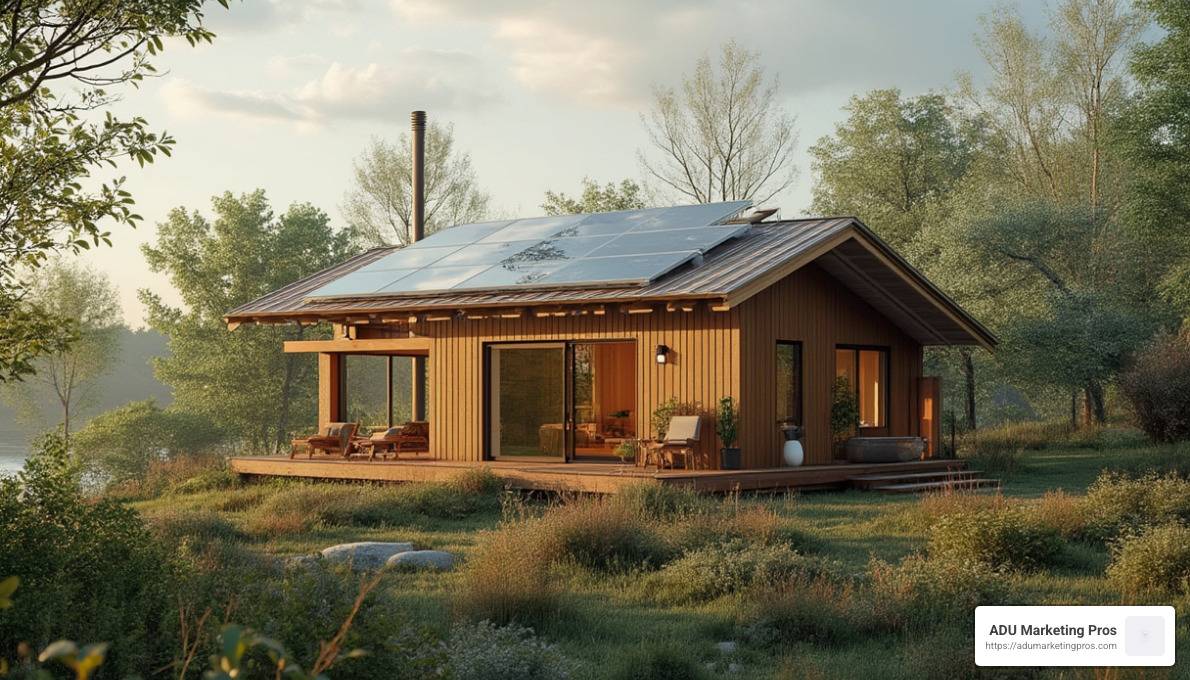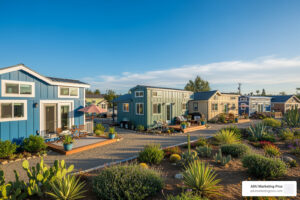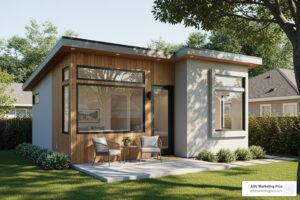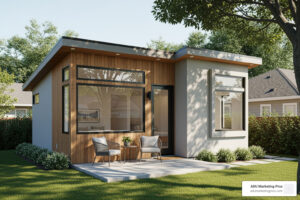Eco-friendly small homes are becoming a popular choice for those who want to live sustainably and accept a minimalist lifestyle. These tiny dwellings offer a simple yet impactful way to reduce one’s environmental footprint without sacrificing comfort or style.
Here’s a quick look at why eco-friendly small homes are gaining popularity:
- Sustainable Living: These homes use less energy and resources, making them an environmentally-friendly option.
- Minimalist Lifestyle: The compact space encourages decluttering and thoughtful consumption.
- Cost Efficiency: Less space means lower utility bills and maintenance costs.
Living in an eco-friendly small home isn’t just a trend—it’s a lifestyle choice that reflects growing awareness about sustainability and environmental impact. For instance, the Wikkelhouse, made from robust cardboard, demonstrates how innovative design can contribute to sustainable living. On the other hand, the Hill House integrates with its natural surroundings, featuring energy-saving technologies and natural materials.
Choosing an eco-friendly small home allows residents to enjoy a simpler life with a lower carbon footprint. These homes often incorporate features such as energy-efficient lighting, solar panels, and rainwater harvesting to create self-sufficient living spaces.

What Makes a Home Eco-Friendly?
Eco-friendly small homes are designed with three main principles in mind: energy efficiency, sustainable materials, and carbon footprint reduction. These elements work together to create a living space that is not only kind to the environment but also beneficial to the homeowner.
Energy Efficiency
Energy efficiency is a cornerstone of eco-friendly homes. These homes use less energy by integrating technologies such as:
- LED Lighting: LED lights consume up to 90% less power than traditional bulbs.
- Energy-Efficient Appliances: Appliances designed to consume minimal energy without sacrificing performance.
- Solar Panels: Many eco-friendly homes are equipped with solar panels, allowing for off-grid living and reduced reliance on fossil fuels.

Sustainable Materials
Building materials play a crucial role in the sustainability of a home. Eco-friendly small homes often use:
- Recycled and Recyclable Materials: Utilizing materials like reclaimed wood or recycled metal reduces the demand for new resources.
- Natural Materials: Materials such as straw bales or rammed earth are not only sustainable but also offer excellent insulation properties.
The Wikkelhouse is a prime example of this approach, using cardboard and pine wood to create a durable and sustainable structure.
Carbon Footprint Reduction
Reducing the carbon footprint is a major goal for eco-friendly homes. This is achieved through:
- Efficient Design: Homes are designed to maximize natural light and airflow, minimizing the need for artificial heating and cooling.
- Water Conservation: Features like rainwater harvesting systems and composting toilets help conserve water and reduce waste.
The Hill House exemplifies how integrating with natural surroundings and using smart house systems can significantly lower a home’s carbon emissions.
By focusing on these key areas, eco-friendly small homes offer a sustainable living solution that aligns with the growing need to protect our planet. These homes not only provide a comfortable living environment but also encourage a more responsible and conscious way of life.
Types of Eco-Friendly Small Homes
Eco-friendly small homes come in various forms, each offering unique benefits and challenges. Let’s explore some popular types:
Tiny Homes
Tiny homes are compact, efficient, and designed to minimize resource use. They are often built with sustainable materials like reclaimed wood and recycled metal. The Ohariu by First Light Studio is a great example, featuring a minimalist design powered by solar energy.
Tiny homes are ideal for those looking to reduce their carbon footprint while embracing a minimalist lifestyle. They are cost-effective and can be easily moved, offering flexibility and freedom.
Prefabricated (Prefab) Homes
Prefab homes are built in sections at a factory and then assembled on-site. This method reduces construction waste and speeds up the building process. Companies like Mighty Small Homes use structural insulated panels (SIPs) for greater energy efficiency and strength.
These homes can be customized to fit various needs, from single-family residences to vacation homes, making them a versatile choice for eco-conscious buyers.
Earthships
Earthships are designed to operate completely off-grid, using renewable energy sources like sun, wind, and water. These homes are constructed with recycled materials, such as tires and aluminum cans. The design of Earthships allows them to maintain comfortable temperatures year-round without traditional heating or cooling systems.
Architect Michael Reynolds, the mastermind behind Earthships, envisioned homes that coexist with the environment, minimizing ecological impact. They are a perfect choice for those seeking a self-sustaining lifestyle.
Shipping Container Homes
Shipping container homes repurpose old shipping containers into living spaces. This innovative approach reduces waste and uses existing resources, making it a sustainable option. The robust steel structure of containers provides durability and protection against harsh weather conditions.
These homes can be stacked or arranged in various configurations, allowing for creative and flexible designs. They are also relatively affordable, making them an attractive choice for eco-friendly living.
Rammed Earth Homes
Rammed earth homes use natural earth materials, compacted to form strong, insulating walls. This ancient building technique offers excellent thermal mass, reducing the need for artificial heating and cooling.
The use of local soil and minimal processing makes rammed earth homes a low-carbon option. They blend seamlessly with natural surroundings, offering a unique aesthetic and a deep connection to the environment.
These eco-friendly small homes provide diverse options for sustainable living, each with its own set of advantages. Whether it’s the mobility of tiny homes, the efficiency of prefabs, or the self-sufficiency of Earthships, there’s a green home solution for everyone.
Benefits of Eco-Friendly Small Homes
Eco-friendly small homes are gaining popularity for several reasons. They offer a range of benefits that make them appealing to those looking to live sustainably and economically.
Cost-Effective
One of the biggest advantages of eco-friendly small homes is their affordability. They are generally cheaper to build and maintain compared to traditional homes. For instance, the Rural Studios in Alabama have developed sustainable homes using just $12,000 of materials and $8,000 of labor. This makes owning a home more accessible to a wider audience.
Energy Savings
These homes are designed with energy efficiency in mind. By using features like solar panels and energy-efficient appliances, homeowners can significantly reduce their utility bills. In fact, Mighty Small Homes claims that their prefab kits can lower heating and cooling costs by up to 60%. This not only saves money but also reduces the home’s carbon footprint.
Reduced Waste
Eco-friendly small homes often use sustainable materials such as recycled wood and metal. Prefabricated homes, for example, are constructed in a way that minimizes waste during the building process. This approach not only conserves resources but also lessens the environmental impact of construction.
Mobility
Many small homes, like those offered by Green Tiny, are built on wheels, providing the flexibility to move them as needed. This mobility allows homeowners to relocate without the hassle of traditional moving processes. It also offers the freedom to explore new locations and live closer to nature.
Minimalist Lifestyle
Living in a small home encourages a minimalist lifestyle. With limited space, homeowners are prompted to declutter and prioritize what’s truly important. This shift can lead to a simpler, more fulfilling life. As David Attenborough wisely said, “It’s surely our responsibility to do everything within our power to create a planet that provides a home not just for us, but for all life on Earth.”
These benefits make eco-friendly small homes an attractive choice for those seeking to live sustainably and economically. By embracing this lifestyle, individuals can enjoy a reduced carbon footprint, lower living costs, and a greater connection to the environment.
Next, let’s dig into the key features that make these homes eco-friendly and sustainable.
Key Features of Eco-Friendly Small Homes
Eco-friendly small homes are designed with sustainability at the forefront. They incorporate several key features that make them both environmentally friendly and efficient.
LED Lighting
LED lights are a staple in eco-friendly homes. They use up to 75% less energy than traditional incandescent bulbs and last much longer. This not only cuts down on electricity bills but also reduces the frequency of bulb replacements, minimizing waste.
Solar Panels
Solar panels are a game-changer for small homes aiming to go off-grid. They convert sunlight into electricity, providing a renewable energy source that can power the entire home. Homes like the Ohariu by First Light Studio are designed to be net-zero, thanks to their solar-powered systems.
Rainwater Harvesting
Collecting rainwater is an effective way to conserve water. Many eco-friendly small homes are equipped with rainwater harvesting systems that capture and store rainwater for household use. This reduces reliance on municipal water supplies and is particularly useful in areas prone to water shortages.
Composting Toilets
Composting toilets are an excellent addition to any eco-friendly home. They treat human waste through aerobic decomposition, turning it into compost. This not only reduces water usage but also provides a nutrient-rich soil amendment for gardens.
Recycled Materials
Using recycled materials is a hallmark of sustainable construction. Homes like the Wikkelhouse are built with innovative materials like virgin fiber cardboard and eco-friendly glue. These materials are not only sustainable but also durable, ensuring the home stands the test of time.
By incorporating these features, eco-friendly small homes significantly lower their environmental impact and offer a sustainable living solution. They are a testament to how thoughtful design and technology can come together to create homes that are both functional and kind to our planet.
Next, we’ll address some frequently asked questions about eco-friendly small homes and explore the different types available.
Frequently Asked Questions about Eco-Friendly Small Homes
What is the most eco-friendly type of house?
When it comes to eco-friendly small homes, several types stand out for their sustainability. Zero carbon homes are designed to produce as much energy as they consume, effectively balancing out their carbon footprint. They use renewable energy sources like solar or wind power to achieve this balance.
Another standout is the Passivehaus (or Passive House) standard, which focuses on energy efficiency through superior insulation, airtight construction, and strategic ventilation. These homes maintain comfortable indoor temperatures with minimal energy use.
Earthships are also noteworthy. Made from natural and recycled materials, these homes are self-sufficient and incorporate passive solar heating and cooling, rainwater harvesting, and food production. They embody a holistic approach to sustainable living.
How much does it cost to build an eco-friendly house?
The cost of building an eco-friendly house varies widely based on location, size, and the green components included. On average, these homes can range from $150 to $300 per square foot.
For example, prefab options like those from EcoCraft Homes can start at around $285,000, while more custom designs may cost more. In areas with high labor costs or strict building codes, prices can increase. However, the long-term savings on energy and water bills often offset the initial investment.
Are tiny homes more eco-friendly?
Tiny homes are often more eco-friendly compared to traditional houses. Their smaller size means they require fewer resources to build and maintain. This results in less waste and lower energy consumption.
They typically incorporate sustainable features like solar panels, LED lighting, and composting toilets, further reducing their environmental impact. Additionally, tiny homes promote a minimalist lifestyle, encouraging owners to live with less and reduce their carbon footprint.

By choosing an eco-friendly small home, you not only contribute to a healthier planet but also enjoy a more sustainable and cost-effective way of living. These homes represent a growing trend towards responsible housing that meets the needs of both people and the environment.
Next, we’ll explore how ADU Marketing Pros can help you steer sustainable architecture and market differentiation.
Conclusion
At ADU Marketing Pros, we understand the growing demand for eco-friendly small homes and the unique challenges that come with marketing sustainable architecture. As the trend towards sustainable living continues to rise, it’s crucial for ADU construction and architecture firms to differentiate themselves in a competitive market.
Sustainable architecture is not just a trend; it’s a commitment to creating homes that are kinder to our planet. By focusing on energy efficiency, the use of sustainable materials, and reducing carbon footprints, these homes offer a responsible and forward-thinking approach to housing. As more people become eco-conscious, the demand for such homes is expected to grow.
Market differentiation is key in this evolving landscape. Our expertise lies in helping ADU firms stand out by emphasizing their specialized knowledge and commitment to sustainability. We believe that expertise should take precedence over price, allowing firms to attract high-quality leads who value premium, sustainable solutions.
Our custom ADU marketing solutions are designed to highlight these unique selling points. We employ targeted SEO, PPC, and social media strategies to ensure that your firm reaches the right audience—those who are ready to invest in high-quality, eco-friendly living spaces.
As the market for eco-friendly small homes continues to expand, partnering with ADU Marketing Pros ensures that your firm is well-positioned to capture and convert this demand into tangible growth. Together, we can drive the success of your business while contributing to a more sustainable future.




